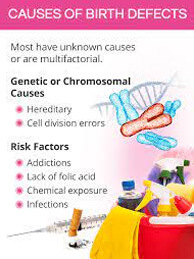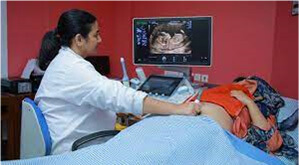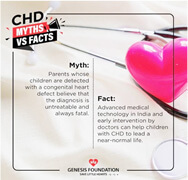Heart Disorders in Children – one of the Leading Birth Defects
March 2, 2023 | Contributed by Preeti Kumar
Birth defects refer to defects in the structure of a baby’s body parts or organs that are present from birth. These are also known as congenital abnormalities or congenital disorders. Globally, approximately 3-5% children are born with a birth defect. Although birth defects may be the result of one or more genetic, infectious, nutritional or environmental factors, it is often difficult to identify the exact cause.
Birth defects are of different types. The most common out of these are congenital heart defects or heart disorders in children, Club Foot, Down Syndrome, Cleft Lip and Cleft Palette and defects in the way the limbs have been formed.
 Cleft Lip is a common birth defect
Cleft Lip is a common birth defect
Every year, March 3 is observed as the World Birth Defect Day. It was created to raise awareness about birth defects and promote screening for them. Early detection and screening of birth defects is critical as it helps parents prepare for the birth of the baby and be ready with the immediate steps that need to be taken to help the baby grow and develop well. The observance of this day is also a time for parents to learn about their children’s health and ask questions about developmental milestones, growth, development, and behaviour.
What Causes Birth Defects?

There are no know causes of birth defects. Genetic factors and exposure to certain environmental toxins can pre-dispose the foetus to be born with a birth defect. In some defects like the Turner’s Syndrome, chromosomes or a part of the chromosome maybe missing causing the defect. In addition, exposure to certain medications, chemicals and toxic substances can also cause defects in the developing foetus. Additionally, the mother being exposed to certain infections during pregnancy such as Rubella, Zika Virus etc can sometimes lead to defects in the developing foetus.
Thus, there is no known reason for the development of birth defects in a foetus, but being careful regarding some conditions mentioned above can minimise the risk of the child developing these.
How are birth defects diagnosed?
 Pre natal scans are critical in diagnosing birth defects
Pre natal scans are critical in diagnosing birth defects
Structural birth defects are present at birth and can be diagnosed during the pre-natal stage through screening. Prenatal ultrasounds are critical in screening for birth defects. The scans done in the 11-13th weeks of pregnancy screen the foetus for any structural abnormalities. At the 20th week a complete scan is conducted from head to toe which looks at any congenital abnormalities in the foetus. Some birth defects are not diagnosed until the baby is born. Hence new-born screening by qualified neonatologists becomes critical. A timely diagnosis of a birth defects is important to ensure that the child is given the access to best possible treatment and opportunities to grow and develop.
Heart Disorders in Children
Heart defects are the most common birth defects. Heart defects are a group of birth defects that affect the heart’s structure and/or function. These defects cause problems in the child’s heart rhythm and/or blood flow. The child heart treatment for some heart defects include surgery while others require lifelong medical care and follow up.
Signs of a congenital heart defect include:
- Rapid heartbeat
- Rapid breathing
- Problems in taking mothers feed – inability to take feed in one single stretch, accompanied with sweating and breathlessness during feeds
- Repeated chest infections within a year
- Poor weight gain
- Blue colour of skin and lips
- Unable to keep up with his/her friends
 Congenital heart defects can be treated
Congenital heart defects can be treated
Congenital heart defects are of different types and also vary in terms of their severity. Critical congenital heart defects can usually be diagnosed during pregnancy during a foetal echocardiogram. This test looks at the structure of the heart and whether the heart is functioning the way it should. The more severe a congenital heart defect, the more likely it is to be diagnosed during the ante-natal stage. Milder heart defects are likely to get diagnosed at birth or once the child is older and starts showing symptoms. Most congenital heart defects can be treated. The child heart treatment depends on the type and severity of the defect and hence a timely diagnosis remains key.
The World Heart Federation estimates that 1 in 4 babies is born with some kind of a congenital heart defect, however, this number is likely to be an underestimate because many cases go unrecognised until later in life.
Implications of a child being born with a birth defect:
No parent wants to hear the words that their foetus has a defect. It immediately throws the parents into a world and on a journey, they were never prepared for. Yet, however difficult it may seem, it is important to understand the diagnosis and prepare oneself. In todays’ world with so many developments in technology, many of the defects can be treated and hence a timely diagnosis remains critical.
Awareness and information are the key for families to understand what defect the child has been born with and what are the necessary steps they need to take to ensure the best possible outcome for the child.
This World Birth Defects Day, the world has come together to raise awareness about these issues. Help join this cause and spread the awareness regarding all birth defects – #ManyBirthDefects1Voice

